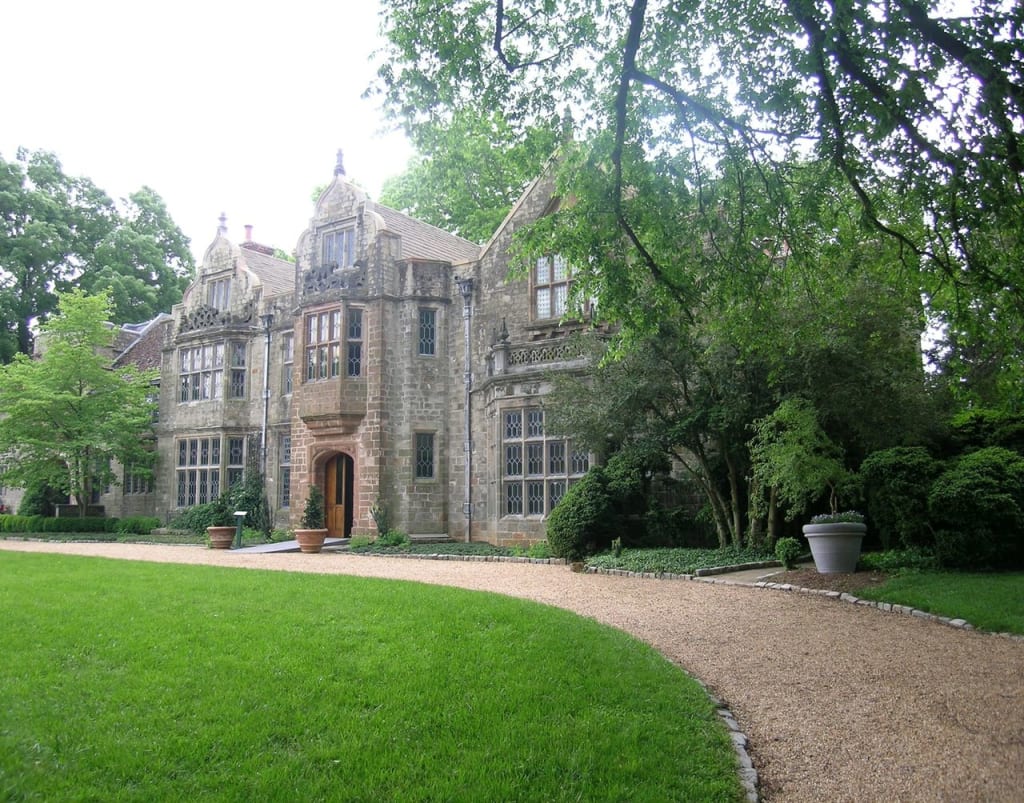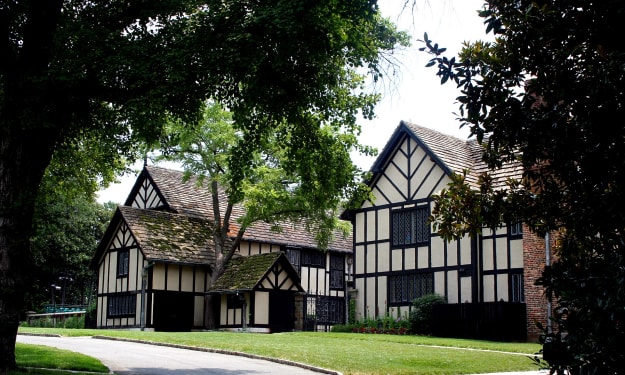Virginia House
This Tudor manor house was once located in Warwick, England.

Virginia House was once located in Warwick, England, where it had been re-modelled a series of times by various owners before making the journey across the Atlantic to Virginia.[1] Its original location formed part of a succession of buildings that had stood on the site for almost nine hundred years. Between the years of 1114 and 1119, the Priory of Saint Sepulchre was founded on the site by Henry de Newburgh, the first Earl of Warwick. In 1547, the original buildings were pulled down and a mansion built, finished in 1566. The home was once again sold in 1584, to Sir John Puckering, a lawyer and Speaker of the House of Commons. He remodelled the house somewhere between the years 1581 and 1611. In 1727, the house was acquired by Henry Wise, Royal Gardener to Queen Anne and George I, staying in the family until 1851 when it was sold to the Oxford Junction Railway Company.[2] The house was sold in 1925, where it was purchased by American Diplomat Alexander Weddell and his wife.[3]
Alexander Weddell was an ardent Anglophile, he travelled and collected all over the world, accumulating a personal library of more than ten thousand volumes and pamphlets.[4] Weddell's father was a member of one of the oldest churches in Richmond and was part of a congregation derived from some of the most prominent families in the area. Alexander Weddell grew up as part of the traditional Virginian elite and strove to preserve the role that Virginia had played in the history of the United States.[5]
Virginia was heavily influenced by England and is the oldest English colony. The Virginian elite has longed seen themselves as counterparts to the landed English gentry.[6] Alexander served as secretary to the minister of Denmark, during which time he moved in distinguished social circles, meeting Lord and Lady Fareham of England, becoming involved in the centennial celebrations of the Peace Treaty at Ghent. However, the main purpose of the celebrations was to improve the relationship between England and America through the restoration of Sulgrave Manor, George Washington's ancestral home, what part of Virginia House would be modelled on when Weddell re-built it in America.[7]
The Weddells had initially planned on constructing a Colonial revival Tudor style property, however, on a trip to England in search of authentic panelling and glass for their new home they came across Warwick Priory in its entirety and in its English setting, concluding that the real thing would be much better than an imitation.[8] On the news that Warwick Priory was to be demolished and transported across the Atlantic, there was local public uproar. Letters of concern were sent to local newspapers which decried the liberty of the Weddells, lobbying for government intervention. Some British citizens felt that the transplantation of this piece of historic old England was a tragedy. However, at the time, many British people felt animosity towards the United States in relation to the First World War. The English had suffered great financial and human loss whilst the United States has prospered.[9] However, as with Agecroft Hall, the sale was allowed to go ahead and the property was sold and shipped to America.[10]
Construction of the home took three years and was overseen by architect, Allen J. Saville, with the gardens landscaped by landscape architect Charles Gillette.[11] The Tudor style house is not a complete reconstruction of Warwick Priory, but a hybrid of several parts from different properties. In addition to the materials from Warwick Priory, columns were imported from Spain and a painted ceiling came from a sixteenth-century house that once stood on the site of Knole in England. The west wing of the house is a replica of Sulgrave Manor, the ancestral home of First United States President George Washington, which still stands in rural Northamptonshire today.[12] Jacqueline Taylor has suggested that the portion of Virginia House that was modelled on Sulgrave Manor firmly associates Virginia with its heroic past, whilst Warwick Priory demonstrates Alexander Weddell's aspiration to be associated with aristocratic circles of England and constructed ancestry.[13] The gatehouse wing was modelled on the Spencer family Tudor home of Wormleighton Manor.[14] The same Spencer family that heiress Consuelo Vanderbilt had married into back in 1895.[15] In addition to the building materials, the Weddells traced and purchased other parts of the original priory including; staircases, window glass, panelling, lead pipes and rainwater heads which had been dispersed at the sale.[16] Virginia House was completed in 1928, and in 1929 it was presented to the Virginia Historical Society who remain, owners and operators, today.[17]
The Weddells were part of an American elite group that gained power through industrial wealth. This group acted to preserve the memory of ancestral achievements in the founding of the American nation at a time when there was much social unrest. Immigration from central and southern Europe as well as African-Americans demanding reform in the south evoked a fear that traditional practices would become obsolete. As a result, these white elites would preserve anything that could stand as a symbol of the hegemony of the Anglo-Saxon race in America. Part of this was to provide tangible testimonies of traditional values which, it can be said, is what Virginia house was part of.[18]
Today, the Virginia Historical Society hose various exhibitions on racial inequality and female activism and fully support histories from all cultures and genders.[19] They also encourage all genders, ages, races to get involved in their events. Their most recent exhibition, Today's Agents of Change with the Virginia Museum of History & Culture was to celebrate the 100th anniversary of the ratification of the 19th Amendment, granting women the right to vote. The museum worked with other agents of change from across Virginia to present revised historical narratives and to show the progress for women and minorities in the United States today.[20]
Thanks for reading.
Footnotes
[1] Virginia Museum of History & Culture, Virginia House. Available online: <https://www.virginiahistory.org/collections-and-resources/virginia-history-explorer/virginia-house> [accessed 7 February 2020]
[2] Warwickshire County Record Office, Heritage & Culture, Notes on the History of Warwick Priory. Available online: <https://apps.warwickshire.gov.uk/api/documents/WCCC-863-56> [accessed 5 August 2020]; Jane Brown, Lancelot 'Capability' Brown: The Omnipotent Magician, 1716–1783 (London: Pimlico, 2011), p. 69; Our Warwickshire, Warwick Priory. Available online: <https://www.ourwarwickshire.org.uk/content/article/warwick-priory-3> [accessed 7 May 2020]
[3] Richard G. Wilson, Shaun Eyring & Kenny Marotta, Re-creating the American past: Essays on the colonial revival (Charlottesville: University of Virginia Press, 2006), p. 237.
[4] Old-House Journal, 1997. A Man's Tudor is His Castle. Available online: https://books.google.co.uk/books?id=a795HYh2bucC&pg=PA34&dq=Old-House+Journal,+1997.+A+Man%27s+Tudor+is+His+Castle&hl=en&sa=X&ved=2ahUKEwjj99eh2sfrAhXLGuwKHamNBmoQ6AEwAHoECAAQAg#v=onepage&q=Old-House%20Journal%2C%201997.%20A%20Man's%20Tudor%20is%20His%20Castle&f=false [accessed 7 May 2020] p 34.
[5] Richard G. Wilson, Shaun Eyring & Kenny Marotta, Re-creating the American past, pp. 241–242.
[6] Bruce A. Kimball, The "True Professional Ideal" in America: A History (Maryland: Rowman & Littlefield, 1995), p. 71.
[7] Richard G. Wilson, Shaun Eyring & Kenny Marotta, Re-creating the American past, p. 242.
[8] Richard G. Wilson, Shaun Eyring & Kenny Marotta, Re-creating the American past, p. 239.
[9] Richard G. Wilson, Shaun Eyring & Kenny Marotta, Re-creating the American past, p. 237.
[10] Richard G. Wilson, Shaun Eyring & Kenny Marotta, Re-creating the American past, p. 237.
[11] Old-House Journal, 1997, p 34.
[12] Historic Houses, Sulgrave Manor. Available online: <https://www.historichouses.org/houses/house-listing/sulgrave-manor.html> [accessed 9 July 2020]
[13] Tom Brigden, The Protected Vista: An Intellectual and Cultural History (Routledge: Oxon & New York, 2019), Part 3.
[14] Virginia Museum of History & Culture, Virginia House, The House, Origins of Virginia House. Available online: <https://www.virginiahistory.org/collections-and-resources/virginia-history-explorer/virginia-house/house> [accessed 7 February 2020]; Heather Lynn Skilton, 'A tale of two houses, transported: Virginia House and Agecroft Hall' (Master's thesis, University of Richmond, 1997); Wilson, R. G., et.al, 2006, p 239.
[15] Patterson, Jerry E., The Vanderbilts (New York: Harry N. Abrams, 1989) p 8.
[16] Warwickshire County Record Office, Heritage & Culture, Notes on the History of Warwick Priory. Available online: <https://apps.warwickshire.gov.uk/api/documents/WCCC-863-56> [accessed 5 August 2020]
[17] Virginia Museum of History & Culture, Virginia House, The House, Origins of Virginia House. Available online: <https://www.virginiahistory.org/collections-and-resources/virginia-history-explorer/virginia-house/house> [accessed 7 February 2020]; Heather Lynn Skilton, 'A tale of two houses, transported: Virginia House and Agecroft Hall' (Master's thesis, University of Richmond, 1997), Paper 971.
[18] Richard G. Wilson, Shaun Eyring & Kenny Marotta, Re-creating the American past: Essays on the colonial revival (Charlottesville: University of Virginia Press, 2006), pp. 244–245.
[19] Virginia Museum of History & Culture, Exhibitions. Available online: <https://www.virginiahistory.org/exhibitions>[accessed 26 August 2020]
[20] Virginia Museum of History & Culture, Video & Audio. Available online: <https://www.virginiahistory.org/read-watch-listen/video-and-audio>[accessed 26 August 2020]
[21] Mac Griswold & Eleanor Weller, The Golden Age of American Gardens: Proud Owners, Private Estates, 1890–1940 (New York: Harry N. Abrams, Inc., 1991), p. 207.
[22] Tom Brigden, The Protected Vista: An Intellectual and Cultural History (Oxon & New York: Routledge, 2019), Part 3.
[23] Virginia Museum of History & Culture, Virginia House, The House, Origins of Virginia House. Available online: <https://www.virginiahistory.org/collections-and-resources/virginia-history-explorer/virginia-house/house> [accessed 7 February 2020]; Heather Lynn Skilton, 'A tale of two houses, transported: Virginia House and Agecroft Hall' (Master's thesis, University of Richmond, 1997), Paper 971.
[24] Catherine L. Whalen, 'Wallace Nutting and the Invention of Old America: An Exhibition Review.' Winterthur Portfolio, vol. 39: 2/3, (2004), p. 175.
[25] Heather Lynn Skilton, 'A tale of two houses, transported: Virginia House and Agecroft Hall' (Master's thesis, University of Richmond, 1997), p. 6; Virginia Museum of History & Culture, Virginia House, The House, Origins of Virginia House. Available online: <https://www.virginiahistory.org/collections-and-resources/virginia-history-explorer/virginia-house/house> [accessed 7 February 2020]; Heather Lynn Skilton, 'A tale of two houses, transported: Virginia House and Agecroft Hall' (Master's thesis, University of Richmond, 1997), Paper 971.
[26] Richard G. Wilson, Shaun Eyring & Kenny Marotta, Re-creating the American past: Essays on the colonial revival (Charlottesville: University of Virginia Press, 2006), p. 238.
About the Creator
Armchair Detective
Amateur writer, I mostly write about true crime.






Comments
Armchair Detective is not accepting comments at the moment
Want to show your support? Send them a one-off tip.